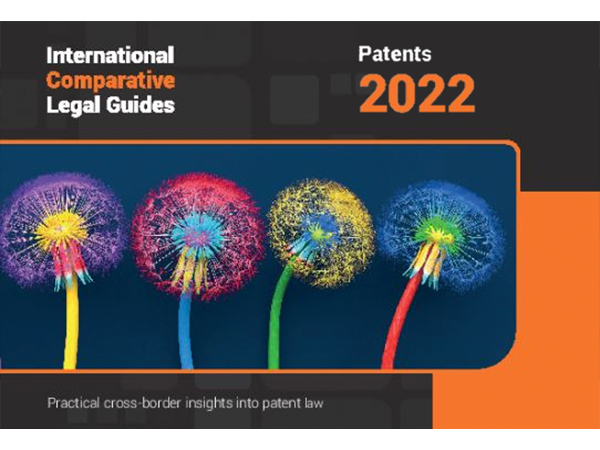
Intellectual Property
Viewpoints
Filter by:
PTAB Clarifies Protocol for Expanded Post-Grant Panels
May 13, 2015 | Blog | By Brad M Scheller
Today the Patent Trial and Appeal Board (“Board”) posted on its website Revision 14 of its Standard Operating Procedure 1 (SOP 1). SOP 1 covers the assignment of Administrative Patent Judges to merits panels, interlocutory panels, and expanded panels in appeals, interferences, and AIA Reviews.
Read more
The PTAB Explores Estoppel in New Representative Decision
May 11, 2015 | Blog | By Kevin Amendt, Brad M Scheller
The Patent Trial and Appeal Board ("the Board") recently announced the addition of its March 26, 2015 decision in Dell, Inc. et al. v. Electronics and Telecomms. Res. Inst., IPR2015-00549 (“the ‘549 IPR”) to its online list of Representative Orders, Decisions, and Notices.
Read more
FTC and DOJ: The PTO’s Efforts to Enhance Patent Quality Will Promote Competition, Innovation, and Consumer Welfare
May 7, 2015 | Blog | By Dionne Lomax
On May 6, 2015, the U.S. Department of Justice (“DOJ”) and U.S. Federal Trade Commission (“FTC”) submitted public comments to the U.S. Patent and Trademark Office (“PTO”) commending the PTO for its efforts to enhance patent quality and making specific recommendations on how the PTO may improve its processes.
Read more
Maximizing Use of the USPTO's Patent Application Alert Service
May 6, 2015 | Blog | By Christina Sperry
The U.S. Patent and Trademark Office (USPTO) recently launched the Patent Application Alert Service (PAAS), a free electronic tool aimed to keep the public apprised of the publication of patent applications.
Read more
‘Last Week Tonight’ Host John Oliver Ignores the Last Three Years of Patent Reform
May 1, 2015 | Blog | By Michael Renaud, Robert Moore
Have you seen John Oliver’s piece about abuses in the patent system? If not, take a look here. The ‘Last Week Tonight’ host has quite a bit of fun at the expense of the patent system.
Read more
Petitioners Must Present Sufficient Evidence to Establish Inherency
April 30, 2015 | Blog | By Brad M Scheller, Inna Dahlin
Last Friday the Patent Trial and Appeal Board (PTAB) denied four Sandoz Inc. petitions for instituting inter partes review (IPR) of U.S. 8,455,524 (IPR2015-00005), U.S. 7,612,102 (IPR2015-00006), U.S. 7,659,290 (IPR2015-00007), and U.S. 7,659,291 B2 (IPR2015-00008) (referred to herein as the “EKR Patents”).
Read more
Helping U.S. Patent Applicants Get Speedy Examination
April 22, 2015 | Blog | By Christina Sperry, Colleen Witherell
U.S. patent applicants often have an interest in expediting the patent examination process. The desire to speed examination can result from issues related to the availability of an inventor, possible infringing activity by a third party, business conditions or the advantageous nature of the technology that require a clear understanding of a stake holders patent rights, or other factors.
Read more
Does the AIA Have a Prior Art Exception You Can Use?
April 21, 2015 | Blog | By Christina Sperry, Inna Dahlin
U.S. patent applications filed after March 16, 2013, when the “First-Inventor-to-File” portion of the America Invents Act (AIA) took effect, have started to be published.
Read more
DOJ Guidance on IEEE Letter Hotly Debated
April 16, 2015 | Blog | By Dionne Lomax
The most hotly debated issue at this year’s GCR IP & Antitrust Conference, held on April 14 in Washington, DC, was the DOJ’s guidance issued in a February business review letter to the Institute of Electrical and Electronics Engineers (IEEE).
Read more
House Judiciary Committee Holds Hearing on Innovation Act, Fee-Shifting
April 15, 2015 | Blog | By Michael Renaud, Robert Moore
Tuesday, April 14, the House Judiciary Committee convened to discuss H.R. 9, the “Innovation Act,” which was introduced in February 2015 by the Committee’s Chairman, Rep. Bob Goodlatte (R-VA).
Read more
FDA Denies Request to Make “Patent Dance” a Prerequisite for Biosimilar Approval
April 3, 2015 | Blog | By Dave Cotta
In a decision released on March 25, 2015, FDA denied a Citizen’s Petition that would have effectively made the information and patent exchange described in § 262 of the Biologics Price Competition and Innovation Act (“BPCIA”) a precondition for approval.
Read more
Quick Fixes and Proposed Rulemaking for PTAB Trial Rules Announced by Director Lee
March 31, 2015 | Blog | By Brad M Scheller
Under Secretary of Commerce for Intellectual Property and USPTO Director, Michelle Lee, announced on Friday that a series of actual and proposed rulemakings aimed at improving post-grant proceedings before the PTAB will be forthcoming—some effective immediately and others rolling out over the summer and beyond.
Read more
Supreme Court to Hear Argument on March 31 Whether to Overrule Brulotte v. Thys, Co.
March 25, 2015 | Blog | By Rich Gervase, Sandra Badin
Fifty years ago, the Supreme Court held in Brulotte v. Thys Co., 379 U.S. 29 (1964) that a license agreement requiring royalty payments for use of a patented invention after expiration of the patent term is unlawful per se.
Read more
USITC Declines to Institute Investigation of Induced Patent Infringement as Unfair Method of Competition or Unfair Acts
March 24, 2015 | Blog
In a recent decision, the International Trade Commission rejected a petitioner’s attempt to use allegations of unfair competition and unfair acts as a possible way of working around the Federal Circuit’s bar on claims of induced infringement.
Read more
Tips for Effectively Organizing PTAB Appeals Brief - Claim Grouping
March 23, 2015 | Blog | By Christina Sperry
Filing an appeal brief with the Patent Trial and Appeal Board (PTAB) can be an effective way to advance prosecution and secure allowable claims. Last November, we summarized Tips for Writing Effective PTAB Briefs to help propel applicants to PTAB victory.
Read more
District Court Rules Against Amgen's Motion for Preliminary Injunction to Prevent Marketing of Sandoz's Biosimilar Zarxio
March 20, 2015 | Blog | By Thomas Wintner, Terri Shieh-Newton
In an order released on March 19, 2015, U.S. District Court Judge Richard Seeborg of the Northern District of California denied Amgen’s motion for judgment on the pleadings as well as its request for a preliminary injunction to prevent Sandoz from marketing its drug Zarxio®.
Read more
Understanding Post-AIA Power of Attorney Procedures
March 19, 2015 | Blog | By Christina Sperry, Colleen Witherell
Applicants identified upon a U.S. patent application’s filing can impact the ownership rights to the patent application throughout prosecution. Prior to implementation of relevant aspects of the America Invents Act (AIA) on September 16, 2012, patent application Applicants could only be Inventors.
Read more
U.S. International Trade Commission Institutes Investigation Under 100-Day Pilot Program Examining Complainant's Standing to File Suit
March 19, 2015 | Blog
The U.S.I.T.C. instituted its first investigation under its 100-day pilot program for early determination of a specific potentially case-dispositive issue.
Read more
Court Denies Generic Drug Manufacturer's Motion to Dismiss Hatch-Waxman Patent Infringement Action on Jurisdiction Grounds
March 18, 2015 | Blog | By Peter Cuomo, Joe Rutkowski
On March 12, the United States District Court for the Southern District of Indiana joined the District of Delaware and Eastern District of Texas as the first courts to consider a generic drug manufacturer’s motion to dismiss a Hatch-Waxman patent infringement action for an alleged lack of personal jurisdiction following the Supreme Court’s decision in Daimler AG v. Bauman, 134 S.Ct. 746 (2014).
Read more
Second Bites At the Post-Grant Apple?
March 13, 2015 | Blog | By Howard Wisnia
The America Invents Act (AIA) gives the Board broad discretion in deciding whether or not to institute an IPR or CBM when the Petition addresses substantially the same prior art or arguments to those previously considered by the PTO.
Read more
Explore Other Viewpoints:
- Antitrust
- Appellate
- Arbitration, Mediation & Alternate Dispute Resolution
- Artificial Intelligence
- Awards
- Bankruptcy & Restructuring
- California Land Use
- Class Action
- Complex Commercial Litigation
- Construction
- Consumer Product Safety
- Cross-Border Asset Recovery
- Debt Financing
- Direct Investing (M&A)
- Diversity
- EB-5 Financing
- Education & Nonprofits
- Employment
- Energy & Sustainability
- Environmental Enforcement Defense
- Environmental Law
- FDA Regulatory
- Federal Circuit Appeals
- Financial Institution Litigation
- Government Law
- Growth Equity
- Health Care
- Health Care Compliance, Fraud and Abuse, & Regulatory Counseling
- Health Care Enforcement & Investigations
- Health Care Transactions
- Health Information Privacy & Security
- IP Due Diligence
- IPRs & Other Post Grant Proceedings
- Immigration
- Insolvency & Creditor Rights Litigation
- Institutional Investor Class Action Recovery
- Insurance & Financial Services
- Insurance Consulting & Risk Management
- Insurance and Reinsurance Problem-Solving & Dispute Resolution
- Intellectual Property
- Investment Funds
- Israel
- Licensing & Technology Transactions
- Life Sciences
- Litigation & Investigations
- M&A Litigation
- ML Strategies
- Medicare, Medicaid and Commercial Coverage & Reimbursement
- Mergers & Acquisitions
- Patent Litigation
- Patent Prosecution & Strategic Counseling
- Pharmacy Benefits and PBM Contracting
- Portfolio Companies
- Privacy & Cybersecurity
- Private Client
- Private Equity
- Pro Bono
- Products Liability & Complex Tort
- Projects & Infrastructure
- Public Finance
- Real Estate Litigation
- Real Estate Transactions
- Real Estate, Construction & Infrastructure
- Retail & Consumer Products
- Securities & Capital Markets
- Securities Litigation
- Special Purpose Acquisition Company (SPACs)
- Sports & Entertainment
- Strategic IP Monetization & Licensing
- Tax
- Technology
- Technology, Communications & Media
- Technology, Communications & Media Litigation
- Trade Secrets
- Trademark & Copyright
- Trademark Litigation
- Venture Capital & Emerging Companies
- White Collar Defense & Government Investigations
- Women's Health and Technology





